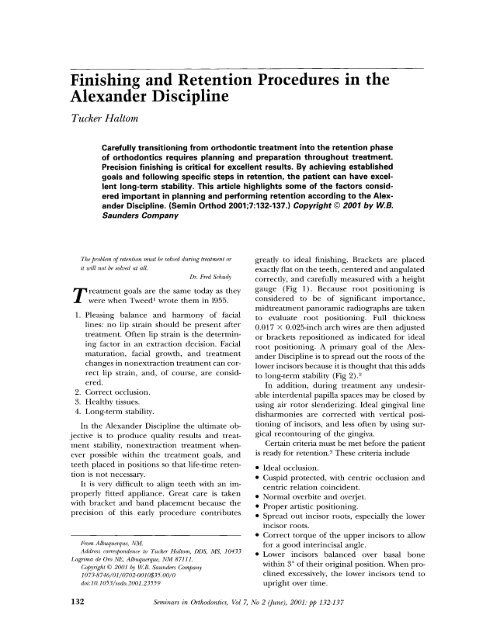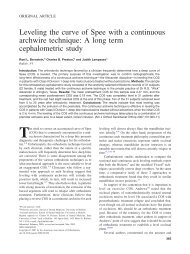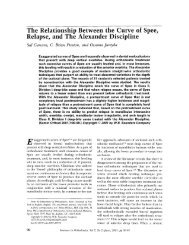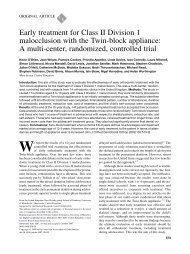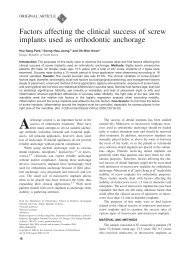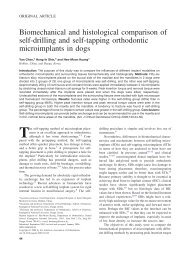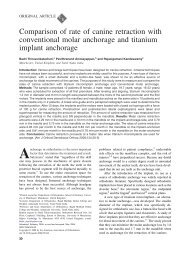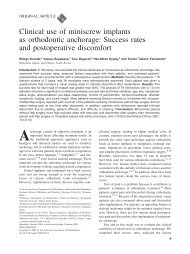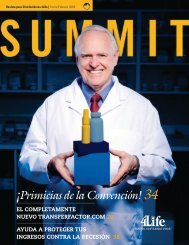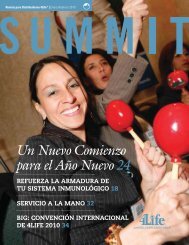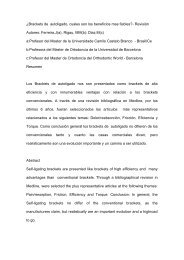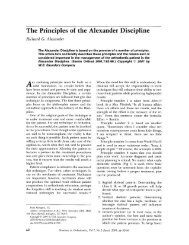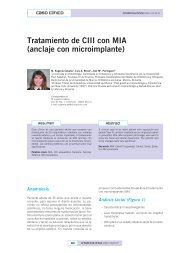Finishing and Retention Procedures in the Alexander Discipline
Finishing and Retention Procedures in the Alexander Discipline
Finishing and Retention Procedures in the Alexander Discipline
You also want an ePaper? Increase the reach of your titles
YUMPU automatically turns print PDFs into web optimized ePapers that Google loves.
<strong>F<strong>in</strong>ish<strong>in</strong>g</strong> <strong>and</strong> <strong>Retention</strong> <strong>Procedures</strong> <strong>in</strong> <strong>the</strong><br />
Alex<strong>and</strong>er Discipl<strong>in</strong>e<br />
Tucker Haltom<br />
Carefully transition<strong>in</strong>g from orthodontic treatment <strong>in</strong>to <strong>the</strong> retention phase<br />
of orthodontics requires plann<strong>in</strong>g <strong>and</strong> preparation throughout treatment.<br />
Precision f<strong>in</strong>ish<strong>in</strong>g is critical for excellent results. By achiev<strong>in</strong>g established<br />
goals <strong>and</strong> follow<strong>in</strong>g specific steps <strong>in</strong> retention, <strong>the</strong> patient can have excel-<br />
lent long-term stability. This article highlights some of <strong>the</strong> factors consid-<br />
ered important <strong>in</strong> plann<strong>in</strong>g <strong>and</strong> perform<strong>in</strong>g retention accord<strong>in</strong>g to <strong>the</strong> Alex-<br />
<strong>and</strong>er Discipl<strong>in</strong>e. (Sem<strong>in</strong> Orthod 2001;7:132-137.) Copyright © 2001 by W.B.<br />
Saunders Company<br />
The problem of retention must be solved dur<strong>in</strong>g treatment or<br />
it will not be solved at all.<br />
Dr. Fred Schudy<br />
T<br />
reatment goals are <strong>the</strong> same today as <strong>the</strong>y<br />
were when Tweed a wrote <strong>the</strong>m <strong>in</strong> 1955.<br />
1. Pleas<strong>in</strong>g balance <strong>and</strong> harmony of facial<br />
l<strong>in</strong>es: no lip stra<strong>in</strong> should be present after<br />
treatment. Often lip stra<strong>in</strong> is <strong>the</strong> determ<strong>in</strong>-<br />
<strong>in</strong>g factor <strong>in</strong> an extraction decision. Facial<br />
maturation, facial growth, <strong>and</strong> treatment<br />
changes <strong>in</strong> nonextraction treatment can cor-<br />
rect lip stra<strong>in</strong>, <strong>and</strong>, of course, are consid-<br />
ered.<br />
2. Correct occlusion.<br />
3. Healthy tissues.<br />
4. Long-term stability.<br />
In <strong>the</strong> Alex<strong>and</strong>er Discipl<strong>in</strong>e <strong>the</strong> ultimate ob-<br />
jective is to produce quality results <strong>and</strong> treat-<br />
ment stability, nonextraction treatment when-<br />
ever possible with<strong>in</strong> <strong>the</strong> treatment goals, <strong>and</strong><br />
teeth placed <strong>in</strong> positions so that life-time reten-<br />
tion is not necessary.<br />
It is very difficult to align teeth with an im-<br />
properly fitted appliance. Great care is taken<br />
with bracket <strong>and</strong> b<strong>and</strong> placement because <strong>the</strong><br />
precision of this early procedure contributes<br />
From Albuquerque, NM.<br />
Address correspondence to Tucker Haltom, DDS, MS, 10433<br />
Lawima de O~v NE, Albuquerque, NM 87111.<br />
Copyright © 2001 by W.B. Saunders Company<br />
1073-8746/01/0702-0010~35. 00/0<br />
doi: 10.1053/sodo. 2001.23559<br />
greatly to ideal f<strong>in</strong>ish<strong>in</strong>g. Brackets are placed<br />
exactly flat on <strong>the</strong> teeth, centered <strong>and</strong> angulated<br />
correctly, <strong>and</strong> carefully measured with a height<br />
gauge (Fig 1). Because root position<strong>in</strong>g is<br />
considered to be of significant importance,<br />
midtreatment panoramic radiographs are taken<br />
to evaluate root position<strong>in</strong>g. Full thickness<br />
0.017 × 0.025-<strong>in</strong>ch arch wires are <strong>the</strong>n adjusted<br />
or brackets repositioned as <strong>in</strong>dicated for ideal<br />
root position<strong>in</strong>g. A primary goal of <strong>the</strong> Alex-<br />
<strong>and</strong>er Discipl<strong>in</strong>e is to spread out <strong>the</strong> roots of <strong>the</strong><br />
lower <strong>in</strong>cisors because it is thought that this adds<br />
to long-term stability (Fig 2).2<br />
In addition, dur<strong>in</strong>g treatment any undesir-<br />
able <strong>in</strong>terdental papilla spaces may be closed by<br />
us<strong>in</strong>g air rotor slenderiz<strong>in</strong>g. Ideal g<strong>in</strong>gival l<strong>in</strong>e<br />
disharmonies are corrected with vertical posi-<br />
tion<strong>in</strong>g of <strong>in</strong>cisors, <strong>and</strong> less often by us<strong>in</strong>g sur-<br />
gical recontour<strong>in</strong>g of <strong>the</strong> g<strong>in</strong>giva.<br />
Certa<strong>in</strong> criteria must be met before <strong>the</strong> patient<br />
is ready for retention. 3 These criteria <strong>in</strong>clude<br />
• Ideal occlusion.<br />
• Cuspid protected, with centric occlusion <strong>and</strong><br />
centric relation co<strong>in</strong>cident.<br />
• Normal overbite <strong>and</strong> overjet.<br />
• Proper artistic position<strong>in</strong>g.<br />
• Spread out <strong>in</strong>cisor roots, especially <strong>the</strong> lower<br />
<strong>in</strong>cisor roots.<br />
• Correct torque of <strong>the</strong> upper <strong>in</strong>cisors to allow<br />
for a good <strong>in</strong>ter<strong>in</strong>cisal angle.<br />
• Lower <strong>in</strong>cisors balanced over basal bone<br />
with<strong>in</strong> 3 ° of <strong>the</strong>ir orig<strong>in</strong>al position. When pro-<br />
cl<strong>in</strong>ed excessively, <strong>the</strong> lower <strong>in</strong>cisors tend to<br />
upright over time.<br />
132 Sem<strong>in</strong>ars <strong>in</strong> Orthodontics, Vol 7, No 2 (]une), 2001: pp 132-137
Figure 1. Measur<strong>in</strong>g bracket height with gauge<br />
aligned evenly with slot torque on all teeth except <strong>the</strong><br />
lower <strong>in</strong>cisors. Measurement is made to slot open<strong>in</strong>g<br />
on <strong>the</strong>se teeth.<br />
• Orig<strong>in</strong>al lower <strong>in</strong>tercuspid width must be<br />
ma<strong>in</strong>ta<strong>in</strong>ed. Exp<strong>and</strong>ed lower cuspids typically<br />
constrict after removal of retention appli-<br />
ances.<br />
• Lower first molars should be upright to ma<strong>in</strong>-<br />
ta<strong>in</strong> a leveled m<strong>and</strong>ibular arch <strong>and</strong> overbite<br />
correction.<br />
• Habits should have been elim<strong>in</strong>ated.<br />
• Midl<strong>in</strong>es should be co<strong>in</strong>cident <strong>and</strong> correct.<br />
• Correct arch form.<br />
• Correct curve of Spee <strong>and</strong> curve of Wilson<br />
should be optimal.<br />
In addition, a circumferential supracrestal fi-<br />
berotomy is performed on all adults with se-<br />
verely rotated teeth 2 months before fixed appli-<br />
ance removal. Removal of hyperplastic tissue <strong>in</strong><br />
<strong>the</strong> maxillary central <strong>in</strong>cisor area is also per-<br />
formed where heavy diastemas are present, es-<br />
pecially if <strong>the</strong>y are considered to be familial<br />
traits.<br />
The Countdown to <strong>Retention</strong><br />
When all <strong>the</strong> goals of <strong>the</strong> optimally treated pa-<br />
tient are met <strong>and</strong> fixed appliance removal time<br />
is approach<strong>in</strong>g, four appo<strong>in</strong>tments are made<br />
with specific objectives for each appo<strong>in</strong>tment.<br />
Appo<strong>in</strong>tment 1: Section<strong>in</strong>g of wires <strong>and</strong> f<strong>in</strong>ish-<br />
<strong>in</strong>g elastics.<br />
Appo<strong>in</strong>tment 2 (3 weeks later): Occlusal check<br />
<strong>and</strong> f<strong>in</strong>al adjustments, <strong>and</strong> possible section<strong>in</strong>g<br />
Alex<strong>and</strong>er Discipl<strong>in</strong>e-<strong>F<strong>in</strong>ish<strong>in</strong>g</strong> <strong>and</strong> <strong>Retention</strong> 133<br />
of <strong>the</strong> oppos<strong>in</strong>g arch wire <strong>and</strong> removal of<br />
molar b<strong>and</strong>s.<br />
Appo<strong>in</strong>tment 3 (3 weeks later) : Fixed appliances<br />
removal.<br />
Appo<strong>in</strong>tment 4 (2 days later): Seat<strong>in</strong>g of <strong>the</strong><br />
reta<strong>in</strong>ers.<br />
These last 6 weeks of treatment are devoted to<br />
f<strong>in</strong>aliz<strong>in</strong>g <strong>the</strong> posterior occlusion <strong>and</strong> <strong>the</strong> ante-<br />
rior overbite. This is accomplished by arch wire<br />
section<strong>in</strong>g <strong>and</strong> <strong>the</strong> wear<strong>in</strong>g of specifically at-<br />
tached elastics: (3/4-<strong>in</strong> 2-oz Ostrich; Ormco,<br />
Glendora, CA) <strong>in</strong> <strong>the</strong> posterior section of <strong>the</strong><br />
arches, <strong>and</strong>, if necessary, placement of an ante-<br />
rior box elastic, (3/16-<strong>in</strong> 6-oz Impala; Ormco).<br />
First Appo<strong>in</strong>tment<br />
Before <strong>the</strong> procedures of this appo<strong>in</strong>tment be-<br />
g<strong>in</strong> <strong>the</strong> patient is given specific <strong>in</strong>structions <strong>and</strong><br />
motivated to follow <strong>the</strong> <strong>in</strong>structions. The patient<br />
is told that <strong>the</strong>y can chew sugarless gum <strong>and</strong> <strong>the</strong><br />
braces will be removed <strong>in</strong> 6 weeks. They are also<br />
<strong>in</strong>formed that elastics are difficult to wear but<br />
must be worn 18 to 20 hours a day<br />
Arch wire section<strong>in</strong>g <strong>and</strong> elastic configura-<br />
tion is determ<strong>in</strong>ed by <strong>the</strong> patient's orig<strong>in</strong>al mal-<br />
occlusion. If <strong>the</strong> beg<strong>in</strong>n<strong>in</strong>g overbite was deep,<br />
<strong>the</strong> lower arch wire is sectioned distal to <strong>the</strong><br />
cuspids <strong>and</strong> <strong>the</strong> posterior arch wires are re-<br />
moved. With open-bite problems, <strong>the</strong> upper<br />
arch wire is sectioned <strong>in</strong> a similar manner. If <strong>the</strong><br />
orig<strong>in</strong>al overbite was close to normal, ei<strong>the</strong>r or<br />
both arch wires may be sectioned. A distal end<br />
cutt<strong>in</strong>g <strong>in</strong>strument with no distal end holder can<br />
be used to section <strong>the</strong> wires <strong>in</strong> <strong>the</strong> mouth or <strong>the</strong><br />
wires can be removed, sectioned, <strong>and</strong> <strong>the</strong> ends<br />
rolled <strong>in</strong> for smoothness. For easy placement<br />
<strong>and</strong> good retention of elastics, <strong>the</strong> wires must be<br />
Figure 2. Panoramic radiograph show<strong>in</strong>g ideal root<br />
position<strong>in</strong>g after appliances removed.
134 Tucker Haltom<br />
Figure 3. <strong>F<strong>in</strong>ish<strong>in</strong>g</strong> elastics with Class II vector.<br />
tied with steel ligatures or Kobayashi hooks<br />
(American Orthodontics, Sheboygan, WI). The<br />
upper <strong>in</strong>cisors may be ligated toge<strong>the</strong>r by us<strong>in</strong>g<br />
a 0.007 ligature wire when <strong>in</strong>dicated. O<strong>the</strong>r ar-<br />
eas susceptible to spac<strong>in</strong>g can also be ligated<br />
toge<strong>the</strong>r.<br />
The <strong>in</strong>termaxillary elastics are attached to<br />
three upper teeth <strong>and</strong> three lower teeth <strong>in</strong> an up<br />
<strong>and</strong> down fashion with specific angulations. 4 If<br />
<strong>the</strong> orig<strong>in</strong>al malocclusion was Class I or Class II<br />
<strong>the</strong>n <strong>the</strong> elastics are worn with a Class II vector<br />
(Fig 3). The same process is followed <strong>in</strong> Class<br />
III occlusions plac<strong>in</strong>g <strong>the</strong> elastics as shown<br />
(Fig 4).<br />
Second Appo<strong>in</strong>tment (3 Weeks Later)<br />
At this time <strong>the</strong> patient is very close to comple-<br />
tion. Maxillary molar b<strong>and</strong>s are now removed.<br />
After check<strong>in</strong>g <strong>the</strong> occlusion, m<strong>in</strong>or f<strong>in</strong>al repo-<br />
sifion<strong>in</strong>g bends may be performed. Patients are<br />
asked to chew <strong>and</strong> squeeze sugarless gum. At this<br />
appo<strong>in</strong>tment, <strong>in</strong>structions for elastic wear at<br />
nighttime only is often given. Tooth shap<strong>in</strong>g<br />
A B C<br />
Figure 4. <strong>F<strong>in</strong>ish<strong>in</strong>g</strong> elastics with Class III vector.<br />
may also be performed. The appo<strong>in</strong>tment for<br />
b<strong>and</strong> removal is made.<br />
Third Appo<strong>in</strong>tment (3 Weeks Later)<br />
All rema<strong>in</strong><strong>in</strong>g b<strong>and</strong>s <strong>and</strong> brackets are removed.<br />
The teeth are polished <strong>and</strong> cleaned. Campbell's<br />
polish<strong>in</strong>g sequences are used to produce a beau-<br />
tiful enamel f<strong>in</strong>ish (Fig 5). 5 Interproximal con-<br />
tact po<strong>in</strong>ts are now polished by us<strong>in</strong>g <strong>the</strong> Dome<br />
Interproximal Tooth Stripper (Dome, Inc, Tar-<br />
zana, CA) (Fig 6). This creates a small amount of<br />
space for <strong>the</strong>se teeth to settle <strong>in</strong> <strong>the</strong> arch. It also<br />
smooths <strong>and</strong> lightly flattens <strong>the</strong> contact areas for<br />
added precision <strong>in</strong> <strong>in</strong>terproximal contacts <strong>and</strong><br />
creates a broader contact area to reduce contact<br />
slippage. The Dome wide abrasive strip is used<br />
so it may reach through <strong>the</strong> circumferential su-<br />
pracrestal fibers perform<strong>in</strong>g a slight fiberotomy<br />
as <strong>in</strong>dicated by rotations <strong>and</strong> where age or peri-<br />
odontal condition do not contra<strong>in</strong>dicate <strong>the</strong><br />
procedure. Only <strong>the</strong> contact areas are stripped if<br />
<strong>the</strong>re are contra<strong>in</strong>dications to a fiberotomy.<br />
Figure 5. Results after polish<strong>in</strong>g enamel. Lateral (A), frontal (B), <strong>and</strong> lateral (C).
Figure 6. Interproximal enamel reduction with Dome<br />
stripper.<br />
The four treatment goals of <strong>the</strong> Mex<strong>and</strong>er<br />
Discipl<strong>in</strong>e <strong>in</strong> <strong>the</strong> lower cuspid to cuspid area that<br />
lead to long-term stability are (Fig 7)<br />
1. Ma<strong>in</strong>ta<strong>in</strong> <strong>the</strong> cuspid-to-cuspid width close to<br />
<strong>the</strong> orig<strong>in</strong>al dimension.<br />
2. Lower <strong>in</strong>cisors upright with<strong>in</strong> 3 ° of orig<strong>in</strong>al<br />
angulation.<br />
3. Roots of lower <strong>in</strong>cisors spread out properly.<br />
4. Interproximal enamel reduction done.<br />
Impressions for work<strong>in</strong>g models <strong>and</strong> f<strong>in</strong>al<br />
models are taken <strong>and</strong> <strong>the</strong> posttreatment review<br />
is conducted. One of <strong>the</strong> joys <strong>in</strong> orthodontics is<br />
to celebrate with <strong>the</strong> patient <strong>and</strong> parents after<br />
appliances are removed. Show<strong>in</strong>g <strong>the</strong> changes<br />
achieved dur<strong>in</strong>g treatment re<strong>in</strong>forces <strong>the</strong> need<br />
to follow <strong>in</strong>structions dur<strong>in</strong>g retention. The<br />
third molar teeth are also discussed.<br />
Fourth Appo<strong>in</strong>tment<br />
Two days after <strong>the</strong> appliances are removed, <strong>the</strong><br />
reta<strong>in</strong>ers are seated. 6<br />
The Maxillary Reta<strong>in</strong>er<br />
A wraparound reta<strong>in</strong>er design is constructed<br />
with <strong>the</strong> facial bow soldered to C-clasps around<br />
<strong>the</strong> term<strong>in</strong>al molar (usually second molars). A<br />
preformed reta<strong>in</strong>er wire (Fig 8) has been de-<br />
signed to elim<strong>in</strong>ate <strong>the</strong> tendency <strong>in</strong> previous<br />
designs for <strong>the</strong> anterior portion of <strong>the</strong> wire to<br />
slip g<strong>in</strong>givally. The advantages of this preformed<br />
wire <strong>in</strong>clude<br />
Alex<strong>and</strong>er Discipl<strong>in</strong>e-<strong>F<strong>in</strong>ish<strong>in</strong>g</strong> <strong>and</strong> <strong>Retention</strong> 135<br />
Figure 7. <strong>F<strong>in</strong>ish<strong>in</strong>g</strong> goals for lower anteriors.<br />
2. Round surface aga<strong>in</strong>st <strong>the</strong> lips for comfort.<br />
3. Increased wire stiffness that resists slipp<strong>in</strong>g<br />
g<strong>in</strong>givally.<br />
4. Lateral <strong>in</strong>cisor offset bends.<br />
5. Smaller adjustment loops positioned more<br />
posteriorly.<br />
6. Arch form conforms to Alex<strong>and</strong>er/Orthos<br />
design.<br />
This preformed reta<strong>in</strong>er wire allows much<br />
faster adaptation <strong>in</strong> <strong>the</strong> laboratory so that re-<br />
ta<strong>in</strong>er construction is more efficient. Also, <strong>the</strong><br />
appliance is much more "patient friendly" be-<br />
cause of <strong>the</strong> wire's stiffness <strong>and</strong> <strong>the</strong> unique an-<br />
terior wire-<strong>and</strong>-loop design.<br />
Special attention should be given to <strong>the</strong> up-<br />
per second molars. In many cases, <strong>the</strong>se teeth<br />
have not fully erupted when <strong>the</strong> reta<strong>in</strong>er is con-<br />
structed <strong>and</strong> <strong>the</strong>refore <strong>the</strong> acrylic on <strong>the</strong> l<strong>in</strong>gual<br />
<strong>and</strong> <strong>the</strong> reta<strong>in</strong>er wire on <strong>the</strong> distal should be<br />
contoured to allow <strong>the</strong> teeth to cont<strong>in</strong>ue to<br />
erupt. This is accomplished by plac<strong>in</strong>g a C-clasp<br />
around <strong>the</strong> maxillary second molar. The clasp is<br />
1. Flat surface aga<strong>in</strong>st <strong>the</strong> anterior teeth for<br />
stability. Figure 8. Preformed wraparound reta<strong>in</strong>er wire.
136 Tuck~ Haltom<br />
Figure 9. "C" clasp not touch<strong>in</strong>g distol<strong>in</strong>gual cusp of<br />
second molar.<br />
designed so that it does not touch <strong>the</strong> distol<strong>in</strong>-<br />
gual cusps (Fig 9). The labial bow reta<strong>in</strong>er wire<br />
is soldered to <strong>the</strong> C-clasp <strong>in</strong> <strong>the</strong> distobuccal cusp<br />
area, leav<strong>in</strong>g enough space to adjust <strong>the</strong> C-clasp<br />
for greater retention. When prepar<strong>in</strong>g <strong>the</strong> max-<br />
illary reta<strong>in</strong>er for delivery, care is taken to recon-<br />
tour <strong>the</strong> acrylic to prevent it touch<strong>in</strong>g <strong>the</strong> l<strong>in</strong>gual<br />
surfaces of <strong>the</strong> teeth (Fig 10). This enables <strong>the</strong><br />
posterior teeth to cont<strong>in</strong>ue settl<strong>in</strong>g after appli-<br />
ance removal. If desired, <strong>the</strong> bite plate is ad-<br />
justed anteriorly to allow <strong>the</strong> teeth to occlude<br />
without touch<strong>in</strong>g any acrylic, so that when <strong>the</strong><br />
patient closes, only teeth are occlud<strong>in</strong>g with<br />
teeth.<br />
Figure 10. Maxillary reta<strong>in</strong>er ready for deliver},.<br />
The M<strong>and</strong>ibular Reta<strong>in</strong>er<br />
In recent years, <strong>the</strong> bonded multistr<strong>and</strong>ed man-<br />
dibular cuspid to cuspid has become very popu-<br />
lar, ma<strong>in</strong>ly because of its ease of placement <strong>and</strong><br />
its effectiveness <strong>in</strong> prevent<strong>in</strong>g relapse. A 0.0915<br />
multistr<strong>and</strong>ed wire (Triple-Flex; Ormco, Glen-<br />
dora, CA) is contoured directly or <strong>in</strong>directly on<br />
<strong>the</strong> l<strong>in</strong>gual surface of <strong>the</strong> anteriors from <strong>the</strong><br />
cuspid to <strong>the</strong> opposite cuspid. In extraction<br />
cases, <strong>the</strong> wire can be extended to <strong>the</strong> mesial<br />
groove of <strong>the</strong> bicuspids. To place <strong>the</strong> reta<strong>in</strong>ers<br />
<strong>the</strong> preformed wire is held <strong>in</strong> place with dental<br />
floss or elastics (Fig 11). The wire is bonded to<br />
each of <strong>the</strong> anterior teeth with a low-viscosity<br />
light-cured bond<strong>in</strong>g agent. If slight lower <strong>in</strong>cisor<br />
malalignments are present, a 90 ° utility plier<br />
(Fig 19) can be used to position <strong>the</strong> contacts<br />
Figure 11. Dental floss hold<strong>in</strong>g 0.0215 multistr<strong>and</strong>ed Figure 12. Utility plier adjust<strong>in</strong>g contact po<strong>in</strong>ts be-<br />
wire. fore light cur<strong>in</strong>g.
properly by gently squeez<strong>in</strong>g <strong>the</strong> teeth as shown.<br />
Instruction for <strong>Retention</strong><br />
The patient is <strong>in</strong>structed to wear <strong>the</strong> maxillary<br />
reta<strong>in</strong>er for only 10 to 12 hours from <strong>the</strong> beg<strong>in</strong>-<br />
n<strong>in</strong>g, putt<strong>in</strong>g it on after <strong>the</strong> even<strong>in</strong>g meal <strong>and</strong><br />
wear<strong>in</strong>g it all night long. This procedure greatly<br />
reduces <strong>the</strong> loss or breakage of reta<strong>in</strong>ers.<br />
<strong>Retention</strong> Appo<strong>in</strong>tments<br />
The patient is seen <strong>in</strong> 8 weeks for f<strong>in</strong>al records<br />
<strong>and</strong> reta<strong>in</strong>er adjustment. Ano<strong>the</strong>r appo<strong>in</strong>tment<br />
is made <strong>in</strong> ano<strong>the</strong>r 8 weeks to adjust <strong>the</strong> re-<br />
ta<strong>in</strong>er. At this time <strong>the</strong> patient may wear <strong>the</strong><br />
reta<strong>in</strong>er only when <strong>the</strong>y sleep.<br />
The patient is <strong>the</strong>n scheduled to return <strong>in</strong> 12<br />
months. The second year <strong>the</strong> maxillary reta<strong>in</strong>er<br />
is worn three times a week, <strong>and</strong> dur<strong>in</strong>g <strong>the</strong> third<br />
year, reta<strong>in</strong>er wear is reduced to once a week.<br />
After a decision has been made relative to <strong>the</strong><br />
third molars, <strong>the</strong> lower cuspid-to-cuspid fixed<br />
reta<strong>in</strong>er may be removed, unless <strong>the</strong> patient pre-<br />
fers that it rema<strong>in</strong> <strong>in</strong> place. The patient is ad-<br />
vised to "Be your own orthodontist" <strong>and</strong> period-<br />
Alex<strong>and</strong>er Discipl<strong>in</strong>e-<strong>F<strong>in</strong>ish<strong>in</strong>g</strong> <strong>and</strong> <strong>Retention</strong> 137<br />
ically place <strong>the</strong> upper reta<strong>in</strong>er to see that it still<br />
fits. At this time <strong>the</strong> patient is released from<br />
active treatment, with <strong>the</strong> knowledge that <strong>the</strong>ir<br />
records are kept on file if needed.<br />
Conclusion<br />
Careful attention to retention problems dur<strong>in</strong>g<br />
treatment, precision <strong>and</strong> artistic f<strong>in</strong>ish<strong>in</strong>g, im-<br />
proved reta<strong>in</strong>er design, <strong>and</strong> a more reasonable<br />
schedule of reta<strong>in</strong>er wear all contribute to<br />
achiev<strong>in</strong>g a beautiful occlusion <strong>and</strong> long-term<br />
stability.<br />
References<br />
1. Tweed CH. Cl<strong>in</strong>ical orthodontics. St. Louis: CV Mosby,<br />
1966.<br />
2. Williams R. Elim<strong>in</strong>ation lower retention. J Cl<strong>in</strong> Orthod<br />
1985;22:342-349.<br />
3. Alex<strong>and</strong>er RG. The Alex<strong>and</strong>er Discipl<strong>in</strong>e. Glendora, CA:<br />
Ormco, 1986.<br />
4. Steffen MJ. Five cent tooth positioners. J Cl<strong>in</strong> Orthod<br />
August, 1987:524-529.<br />
5. Campbell P. Enamel polish<strong>in</strong>g. Angle Orthod 1995;65:<br />
103-110.<br />
6. Alex<strong>and</strong>er RG. <strong>Retention</strong>-a practical approach to that<br />
critical last step to stability. In: Cl<strong>in</strong>ical Impressions. Glen-<br />
dale, CA: Ormco, 1997, 14-17.


